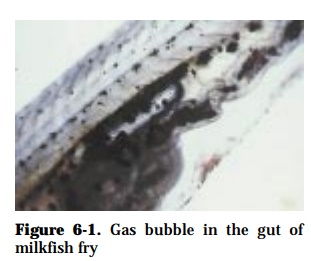Chapter: Health Management in Aquaculture: Environmental and other non-infectious diseases
Gas Bubble Disease - Fish Diseases
Gas Bubble Disease
Gas bubble disease is due to supersaturation of dissolved gases (nitrogen oroxygen); supersaturation may be due to leaks in pump or valve systems in hatcheries; dense algal bloom that presumably caused oxygen depletion at night and supersaturation during the day.
SIGNS:
Affected fish show bubbles in the abdominal cavity, eyes, skin, gills, fins, mouth, swimbladder and within the digestive tract (Fig. 6-1) and exopthalmia. The clinical signs of gas bubble disease should not be confused with Swimbladder stress syndrome because the bubbles in the latter can be seenonly in the swimbladder.

EFFECTS ON HOST:
Death due to embolism in blood and emphysema in tissues; edema and degeneration of the gill lamellae; bulging of the cornea; abrupt mass mortali-ties.
PREVENTION AND CONTROL
• Monitor dissolved oxygen (DO)
• Avoid algal blooms
• Maintain efficient operation of waterlines and pumps
• Sufficient water exchange
Related Topics